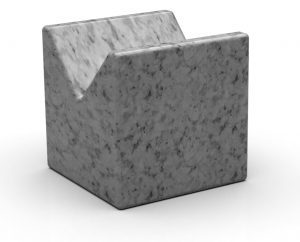A surface plate, is a large, flat, precision tool used as a reference surface for measuring and inspecting the flatness, straightness, parallelism, and other geometric features of workpieces. Surface plates are an essential part of precision measurement and quality control processes in various industries, including manufacturing, engineering, and metrology.

Surface plates are commonly made of granite due to its unique combination of properties that make it well-suited for precision measurement and inspection applications. Here are the main reasons why granite is the preferred material for manufacturing surface plates:
- Stability and Low Thermal Expansion: Granite has an extremely low coefficient of thermal expansion, meaning it changes very little in size due to temperature fluctuations. This property ensures that the surface plate remains dimensionally stable under varying temperature conditions. As temperature changes can affect the accuracy of measurements, using granite helps minimize this potential source of error.
- Hardness and Wear Resistance: Granite is a hard and durable material with excellent wear resistance. The hardness of granite minimizes the wear and deformation that can occur over time from contact with measuring instruments and workpieces. This ensures that the surface retains its flatness and accuracy even after extended use.
- Smooth and Homogeneous Surface: Granite has a naturally smooth and homogeneous surface that can be further polished to a high degree of smoothness. This smooth surface minimizes friction and ensures accurate readings when measuring instruments, such as dial indicators or micrometers, make contact.
- Minimal Absorption and Non-Reactivity: Granite has low porosity and is non-reactive to most chemicals and substances commonly found in manufacturing environments. This property prevents the surface from absorbing moisture, oils, or contaminants that could affect the accuracy of measurements.
- Vibration Damping: Granite has excellent vibration damping properties, which helps reduce the effects of external vibrations or mechanical shocks. This is particularly important in precision measurement environments where even slight vibrations can introduce measurement errors.
- Dimensional Stability: Granite is dimensionally stable over time, which means it doesn’t warp or change shape significantly as it ages. This ensures that the surface plate’s reference dimensions remain consistent over its lifespan. Also, unlike some other materials, damage to a granite surface plate will result in chipping or pitting instead of raising a burr. This means the accuracy of a surface plate can be unaffected by minor damage.
- Non-Magnetic: Granite is non-magnetic, making it suitable for applications where magnetic interference needs to be minimized.
- Availability and Consistency: Granite is widely available and can be sourced in large sizes with consistent quality. This is essential for manufacturing large, high-quality surface plates.
- Ease of Manufacturing: While granite is hard, it can still be precisely machined, ground, and polished to achieve the high flatness and smoothness required for surface plates.


